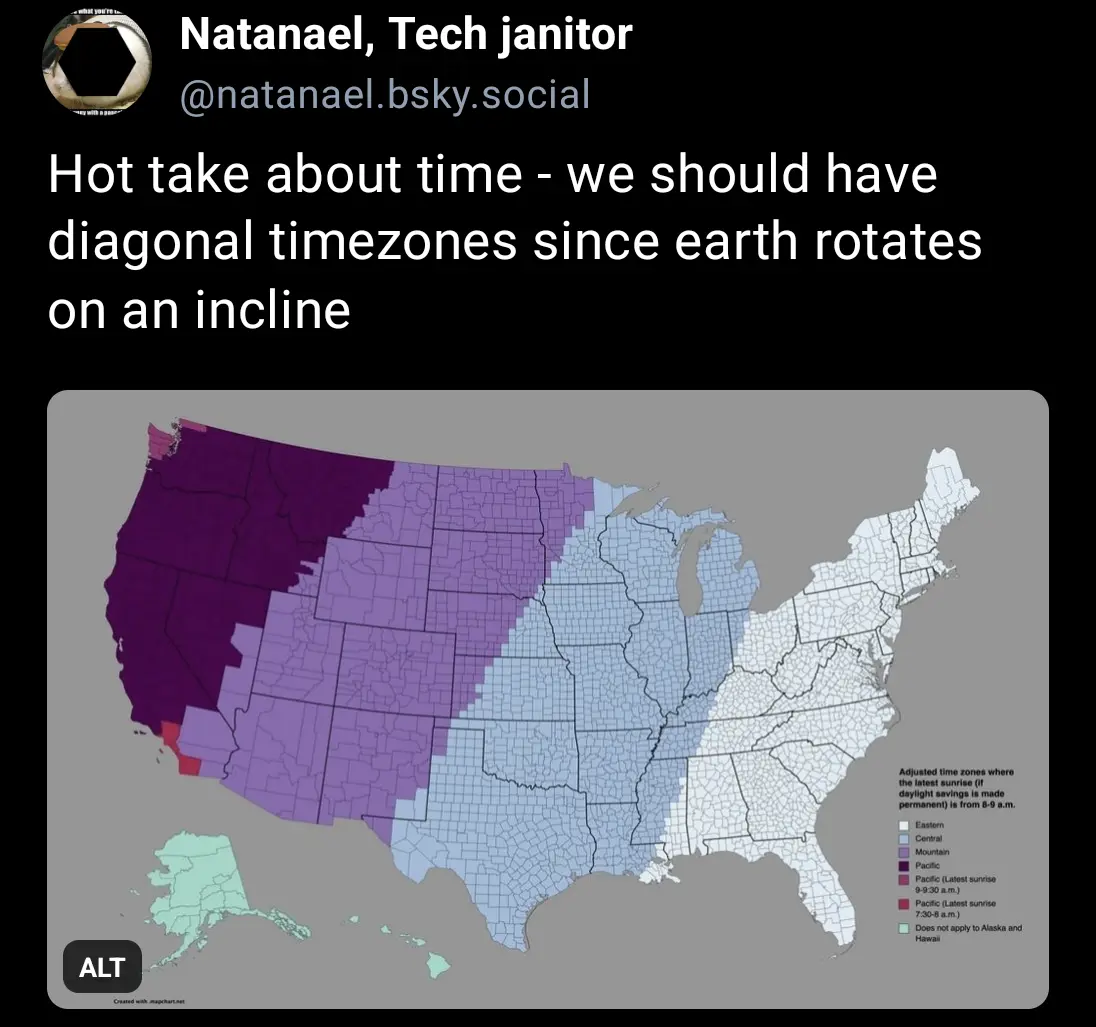0 minutes of daylight is gained from daylight savings time.
60 minutes is how much is shifted to later in the day.
I completely agree with this point. But using the conventions of “business hours” to drag people out of bed earlier allows them to get off work earlier and utilize the daylight they already have more fully. But it is without a doubt a psychological shell game.
There is no amount of daylight I can utilize as I’m not a farmer. Where the sun is has almost no bearing on my life but forcing me to suddenly wake up an hour earlier certainly does
Sounds like somebody needs a soma holiday
The main problem is that the old 9 to 5 business hours puts three hours before noon and five after, which is why DST moves time later in the day.
Just change ‘business hours to’ 8 to 4 and call it a day. or 7:30 to 4:30 if it needs to be 8 hours plus lunch.
Logic and sense? Get out of here! Obviously what we need to do is make daylight saving time permanent year round!
/s, if that wasn’t obvious
Every time I get in an argument with someone who wants year round daylight savings time, they think it happens in the winter.
I don’t know what exactly this is measuring, but the amount of daylight in a day does change throughout the year. If this is measuring the amount of daylight gained from dead winter to the shift, then it actually is increasing the amount of daylight.
“In addition to” makes it sound like it is being added.
It’s definitely in addition to dst, look at the southern states… the blue/cyan is 50 minutes (plus 60)
If you are counting the shifting of 60 minutes to the evening, then you o ly add half of the increase in actual daylight per day to the evening because that is split across noon. You don’t add the whole of both to the evening.
It doesn’t make sense to add those two numbers together in any context.
Useful daylight is gained. Daylight before I wake up is useless to me. Daylight in the evening after work is useful.
Making the sun come up later screws with my sleep schedule and so I don’t get the benefit of the later light.
Daylight when I’m tired is useless to me.
Can’t express how happy I am to finally be coming out of the deep dark. Seattle is a lot better in the summer when the days are like 16 hours long. I love it.
Omg yes. Seattle’s eternal summer dusks are idyllic.
We live in an age now where everyone could potentially sync up with “sunrise” as a floating value.
Your alarm clock will wake you up at sunrise +0.5h (if the sun doesn’t).
Work starts at sunrise +2h.
Daylight savings time no longer exists.
Everything is good.
Take out the “work starts at sunrise +2h” for everything to be good. Work is overrated.
I mean, sure, in a perfect world I would work at my own convenience, but baby steps I suppose.
That probably would work well for those closer to the equator.
But for those in the 100 minutes zone of this map that would mean going to work at 6:30am in the summer (assuming we are using civil twilight as “sunrise”), and 9:30AM in the winter which is much more of a swing than daylight savings puts on us, but at least it is a gradual one.
For those above the Arctic Circle, they just work 24/7 for a couple of weeks in the summer but get a similar time off in the winter ;)
I don’t really see that 3 hour gradual swing as much of a problem. Evolution set sunrise as our “start” by default. Shifting to a more rigid structure leads to a lot of issues involving sleep and depression, so we really should abandon it.
deleted by creator
Why?
There’s a slash through the middle of the country that will lose about 4 minutes of daylight in april
Took me a minute lmao
Nice!
Math enthusists cringe at the discrete bands tho
Damn, sucks for Canada!
Oh ya.
47* states*, most of Arizona has no DST although some of the reservations observe it
DST does not change the amount of sunlight. Just shifts the time frame.
Yes, and refrigerators actually create more heat than cool.
Is that minutes per day, or total?
Minutes per day between the first day and last day of March. I assume.
Minutes per day. I.e. sunrise and sunset on Mar 31 are the indicated number of minutes farther apart than sunrise and sunset on Mar 01.
“SunriseSunset.com provides free custom calendars for any location around the world with sunrise, sunset, moonrise, moonset, moon phases, solstices, equinoxes, and dawn, dusk and other twilight times.”
Check the box for day length when you create your calendar so you can see how many minutes you gain or lose each day.
Total
Cumulative and exponential actually 💩
Would be interesting to see it for a world map
deleted by creator
I have a suggestion…

But don’t forget to awkwardly wrap it around country lines
You think that’s crazy. Think of what it must be like in Alaska!
About 165 minutes for Anchorage… For reference, Helsinki is also 165, Glasgow is 135, London 120, even Milan is 95
Coming from anywhere in Europe the idea of somewhat balanced day lengths throughout the year sounds wild
Are these values inclusive of the 60 minute nonsense?
I would say no, because no daylight is gained by switching from Standard Time to Daylight Savings Time. But even if we did gain an hour with the clock change, this graphic wouldn’t include it b/c that would mean the southern part of the graphic would imply that those folks lost 20 minutes of actual daylight over the month of not got a clock change to save them.
The human made climate crisis at its worst… thanks Obama







